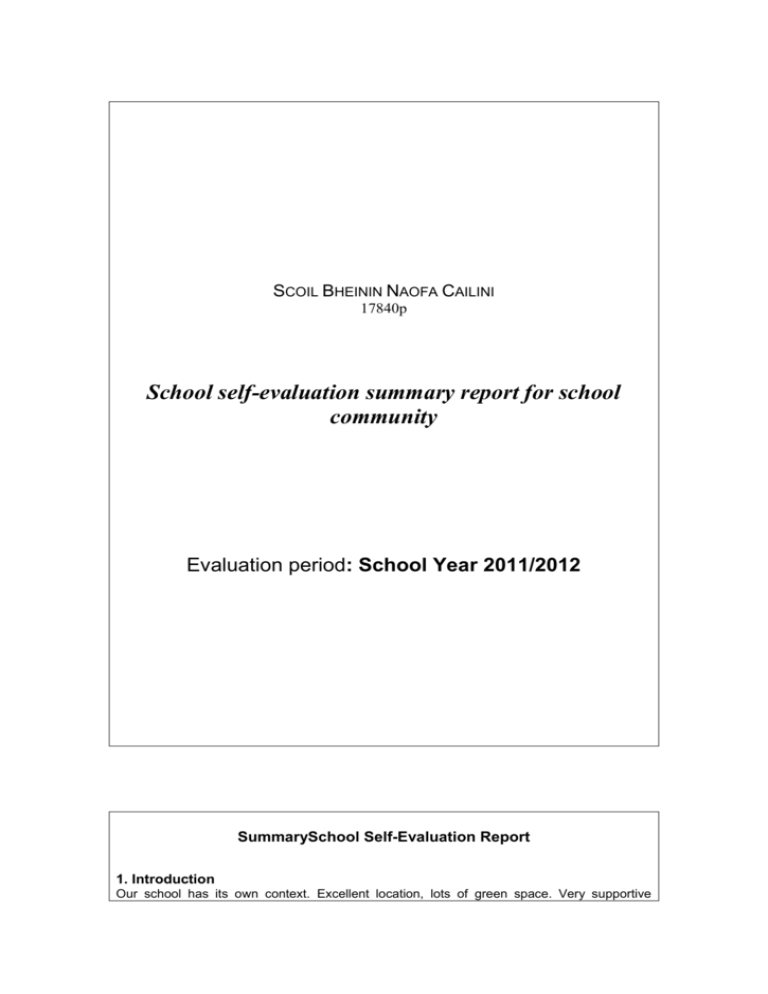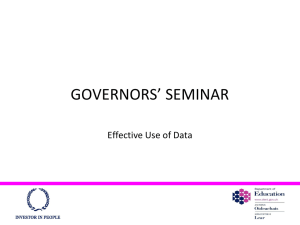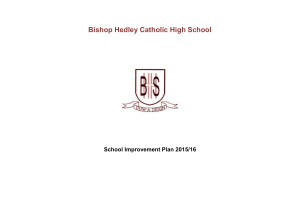Sample template for a summary school self
advertisement

SCOIL BHEININ NAOFA CAILINI 17840p School self-evaluation summary report for school community Evaluation period: School Year 2011/2012 SummarySchool Self-Evaluation Report 1. Introduction Our school has its own context. Excellent location, lots of green space. Very supportive parent body. There are 16 teachers and 330 pupils in the school. Our attendance levels are good .Our pupils’ behaviour is excellent . Numerous extra curricular activities on offer eg, choir ,active week, green schools, digital schools, draughts, instrumental music and orchestra. For more information on how we intend to improve our pupils’ learning, please see our School Improvement Plan which is available on school web site. 1.1 The focus of the evaluation We undertook a school self-evaluation of teaching and learning during the year. We evaluated Literacy and Numeracy.We chose this because we felt that our pupils could improve their learning outcomes in these areas . This report summarises the strengths that were identified and the areas that have been prioritised for improvement. 2. Summary of school self-evaluation findings We collected information from parents, pupils and teachers in preparing this report. We looked at how well our pupils were doing in Numeracy and Literacy .We used the following evaluation methods :teacher reflection ,standardised tests ,analysis of WSE report and teacher observation. We found that our school has strengths in the following areas: Strengths Plans for learning in place. Wide variety of teaching approaches in use Various assesements methods in place ,both assesement of learning and for learning Environment conducive to learning Suitable resources Supportive and active parents . Highly motivated pupil body Motivated staff, High academic standards in all areas We know these are our strengths because of results of SSE. 2.2 We have decided to prioritise the following areas for development: Areas for development Mental Maths. Reading Fluency Reading comprehension We have decided to prioritise these areas because following staff refection etc that children would benefit from focusing on these areas. Appendix to Primary School Self-Evaluation Report: legislative and regulatory checklist – reporting to the school community Rules and regulations for schools are set out in a number of Education Acts, and in Circulars issued to schools from time to time by the Department of Education and Skills. The list below deals with important areas of school life and tells you what rules and regulations apply to them. You will find the Acts and Circulars mentioned on the Department’s website, www.education.ie. Which area of school life is involved, and what are the regulations? Is the school following the regulations fully? The school calendar and the school timetable Circular 11/95 sets down the length of the school year - minimum of 183 days Yes No Circular 11/95 sets down the length of the school day 4 hours 40 minutes (infants); 5 hours 40 minutes (1st-6th classes) Parent/ teacher meetings and staff meetings Circular 14/04 sets out the arrangements for these meetings Implementation of agreement regarding additional time in school for teachers Circular 0008/2011 requires teachers to do an additional 36 hours of out-of-class work each year, so as not to reduce teaching time Standardisation of school year Circular 034/2011 gives the dates for school holidays Valid enrolment of pupils Sections of the Education Act 1998 and the Education (Welfare) Act 2000, and the Rules for National Schools set out the conditions for pupils to be validly enrolled in a school Pupils repeating a year The circumstances in which pupils may repeat a year are set out in Rules for NationalSchools, and circulars 11/01 and 32/03 Development of school plan Section 21, Education Act 1998 requires all schools to have a school plan Engagement with SSE process Circular 39/2012 outlines the school self-evaluation process and what it requires of schools Time for literacy and numeracy - assessing and reporting literacy and numeracy achievement Circular 56/2011 sets out initial actions required in the implementation of the National Literacy and Numeracy Strategy Exemption from Irish Circular 12/96 sets out the circumstances in which children are exempt from studying Irish Implementation of child protection procedures Circular 0065/2011 and the Child Protection Guidelines oblige schools to ensure that: liaison persons have been appointed; the procedures have been communicated to the whole school community; and the procedures are being followed Implementation of complaints procedure as appropriate Section 28 Education Act 1998 provides for procedures to address complaints about a school. Appeals in the case of refusal to enrol students, suspension and expulsion (permanent exclusion) Section 29 Education Act 1998 provides for appeals procedures in these cases, which are dealt with first of all by the school. Where cases are not resolved at school level, an external appeals committee hears the appeal and makes a Yes No Yes No Yes No Yes No Yes No Yes No Yes No Yes No Yes No Yes No Yes No Yes No Complaints have been resolved or are being resolved Yes No N/A Yes No Appeals have been dealt with or are being dealt with Yes No N/A Rules and regulations for schools are set out in a number of Education Acts, and in Circulars issued to schools from time to time by the Department of Education and Skills. The list below deals with important areas of school life and tells you what rules and regulations apply to them. You will find the Acts and Circulars mentioned on the Department’s website, www.education.ie. Which area of school life is involved, and what are the regulations? Is the school following the regulations fully? decision. Appendix to Primary School Self-Evaluation Report: policy checklist – reporting to the school community Schools are required to have certain policies in place as part of their permanent school plan. It is good practice for schools to consult with the school community in forming and reviewing many of these policies. The school board of management has to approve and ratify policies, and should ensure that they are reviewed on a regular basis. Has policy been approved by What area of school life does the policy deal with and what is the aim of the the board of management? policy? Enrolment policy Section (15)(2)(d) Education Act 1998 obliges schools to have and publish an enrolment policy that respects the principles of equality and parental choice Code of behaviour Section 23, Education (Welfare) Act 2000, and the 2008 National Educational Welfare Board Guidelines set out regulations and good practice for schools to follow in drawing up and implementing a code of behaviour Anti-bullying policy Anti-bullying Procedures for Primary and Post-primary Schools, 2013 sets out regulations and good practice for schools to follow in drawing up and implementing an anti-bullying policy Attendance and participation strategy Section 22 Education Welfare Act 2000 requires schools to develop a strategy to support high levels of pupil attendance and participation in school life Health and safety statement All schools should have a health and safety statement that is regularly reviewed (see Section 20 Health and Safety Act 2005) Data protection School procedures relating to gathering, storing and sharing data on pupils should comply with data protection legislation - Data Protection Act 1988 Data Protection (Amendment Act) 2003 Internet acceptable use policy Schools should have and implement a policy to instruct pupils on safe and responsible use of the internet. See www.webwise.ie for guidelines Special education needs policy Various pieces of equality and education legislation, especially the Education for Persons with Special Education Needs Act (EPSEN) 2004, require schools to be inclusive of pupils with special educational needs and to provide for them appropriately using the resources available Relationships and sexuality education (RSE) policy Schools are required to have an RSE policy and to implement it in line with Relationships and Sexuality Education: Policy Guidelines (1997) Substance use policy The National Drugs Strategy and Department Guidelines require schools to develop and implement a policy on substance use, in partnership with parents and other agencies Child protection policy Circular 0065/2011 sets out requirements (see above for details of policy and implementation) Parents as partners Circular 24/91 requests schools to set up a parents’ association, and promotes partnership between home and school Deployment of special needs assistants Circular 71/11 allows for SNAs to be deployed flexibly to respond to the needs of the school Other Yes No Yes No Yes No Yes No Yes No Yes No Yes No Yes No Yes No Yes No Yes No Yes No Yes No




![afl_mat[1]](http://s2.studylib.net/store/data/005387843_1-8371eaaba182de7da429cb4369cd28fc-300x300.png)



